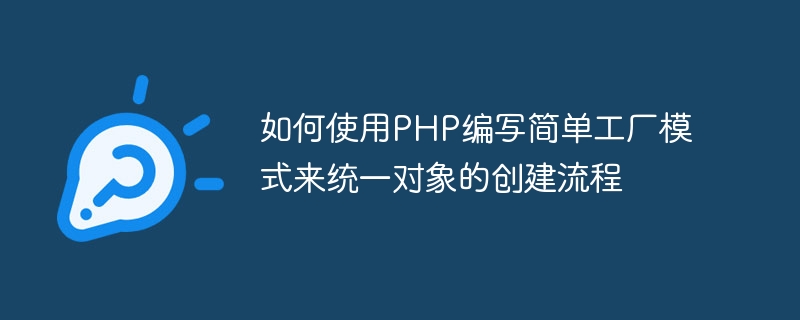

How to use PHP to write a simple factory pattern to unify the object creation process
Simple Factory pattern (Simple Factory) is a creational design pattern that can convert instances of objects into The process of object creation is centralized and the object creation process is unified. The simple factory pattern is very useful in actual projects. It can effectively reduce code redundancy and improve the maintainability and scalability of the code. In this article, we will learn how to use PHP to write a simple factory pattern to unify the object creation process. Let’s first understand the basic concepts of the simple factory pattern.
The basic structure of the simple factory pattern is as follows:
Now, let’s use PHP to write an example to illustrate how to use the simple factory pattern to unify the object creation process.
First, we create an abstract product class Shape, which defines an abstract method calcArea() for calculating the area of the shape.
abstract class Shape {
abstract function calcArea();
}Then, we create concrete product classes Rectangle and Circle, which respectively inherit from the abstract product class Shape and implement the abstract method calcArea().
class Rectangle extends Shape {
private $width;
private $height;
public function __construct($width, $height) {
$this->width = $width;
$this->height = $height;
}
public function calcArea() {
return $this->width * $this->height;
}
}
class Circle extends Shape {
private $radius;
public function __construct($radius) {
$this->radius = $radius;
}
public function calcArea() {
return 3.14 * $this->radius * $this->radius;
}
}Next, we create a factory class ShapeFactory to dynamically create corresponding specific product objects based on the incoming parameters.
class ShapeFactory {
public static function createShape($type, $params) {
switch ($type) {
case 'Rectangle':
return new Rectangle($params['width'], $params['height']);
case 'Circle':
return new Circle($params['radius']);
default:
throw new Exception('Invalid shape type');
}
}
}Finally, we can use the simple factory pattern to create specific product objects. The following is an example:
$rectangle = ShapeFactory::createShape('Rectangle', ['width' => 2, 'height' => 3]);
$circle = ShapeFactory::createShape('Circle', ['radius' => 5]);
echo 'Rectangle area: ' . $rectangle->calcArea() . PHP_EOL;
echo 'Circle area: ' . $circle->calcArea() . PHP_EOL;Run the above code, the following results will be output:
Rectangle area: 6 Circle area: 78.5
Through the above example, we can find that using the simple factory pattern can easily unify the object creation process , you only need to decide which specific product object to create based on the parameters passed in in the factory class, without having to repeat the object creation process multiple times in other places in the code.
To summarize, the simple factory pattern is an extremely simple and commonly used design pattern, suitable for scenarios where multiple objects with the same properties and behaviors need to be created. By using the simple factory pattern, we can centralize the instantiation process of objects and improve the maintainability and scalability of the code.
I hope this article will help you understand and apply the simple factory pattern. For more design patterns and PHP programming content, please stay tuned for other articles.
The above is the detailed content of How to use PHP to write a simple factory pattern to unify the object creation process. For more information, please follow other related articles on the PHP Chinese website!




